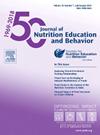Feasibility of a Fruit and Vegetable Home Food Environment Accessibility Intervention
IF 2.3
3区 医学
Q2 EDUCATION, SCIENTIFIC DISCIPLINES
引用次数: 0
Abstract
Objective
Examine the feasibility of an intervention to increase the accessibility of fruit and vegetables for children within the home food environment.
Methods
Thirty-two parents (aged 40.8 ± 4.9 years) and children (aged 9.5 ± 2.4 years) were enrolled in an 8-week pre-post intervention. Each week, parents attended virtual sessions and set goals to increase the accessibility (form, visibility, and reach) of 2 fruits and 3 vegetables. Feasibility indicators measured included retention rate, sessions attended, session length, adherence to goals, and parent satisfaction. Frequencies were used to analyze feasibility indicators, and open-ended questions related to satisfaction were analyzed using thematic analysis.
Results
Retention rate was 94%; average attendance was 7.4 of 8 sessions; session lengths ranged from 9.2 to 15.2 minutes; adherence to 3.6 of 5 goals/wk; and high parent satisfaction.
Conclusions and Implications
Goal setting to increase fruit and vegetable accessibility for children was feasible; however, examining efficacy will be an important next step.
果蔬家庭食品环境可及性干预的可行性研究。
目的:探讨在家庭食品环境中增加儿童水果和蔬菜可及性的干预措施的可行性。方法:对32名家长(年龄40.8±4.9岁)和儿童(年龄9.5±2.4岁)进行为期8周的干预。每周,家长参加虚拟会议,并设定目标,以增加两种水果和三种蔬菜的可访问性(形式,可见性和覆盖面)。测量的可行性指标包括保留率、参加的会议、会议长度、对目标的坚持以及家长满意度。使用频率分析可行性指标,使用专题分析分析与满意度相关的开放式问题。结果:留置率94%;8次会议的平均出勤率为7.4;会话时长从9.2到15.2分钟不等;每周完成5个目标中的3.6个;家长满意度高。结论和意义:设定目标增加儿童水果和蔬菜的可及性是可行的;然而,检查疗效将是重要的下一步。
本文章由计算机程序翻译,如有差异,请以英文原文为准。
求助全文
约1分钟内获得全文
求助全文
来源期刊
CiteScore
4.20
自引率
11.50%
发文量
379
审稿时长
44 days
期刊介绍:
The Journal of Nutrition Education and Behavior (JNEB), the official journal of the Society for Nutrition Education and Behavior, is a refereed, scientific periodical that serves as a global resource for all professionals with an interest in nutrition education; nutrition and physical activity behavior theories and intervention outcomes; complementary and alternative medicine related to nutrition behaviors; food environment; food, nutrition, and physical activity communication strategies including technology; nutrition-related economics; food safety education; and scholarship of learning related to these areas.
The purpose of JNEB is to document and disseminate original research and emerging issues and practices relevant to these areas worldwide. The Journal of Nutrition Education and Behavior welcomes evidence-based manuscripts that provide new insights and useful findings related to nutrition education research, practice and policy. The content areas of JNEB reflect the diverse interests in nutrition and physical activity related to public health, nutritional sciences, education, behavioral economics, family and consumer sciences, and eHealth, including the interests of community-based nutrition-practitioners. As the Society''s official journal, JNEB also includes policy statements, issue perspectives, position papers, and member communications.

 求助内容:
求助内容: 应助结果提醒方式:
应助结果提醒方式:


